ADVENTVS on Roman coins.
"ADVENTVS" means "arrival." The arrival of the emperor to Rome was a major event worthy of celebration and commemoration. The type usually shows the emperor on horseback, raising his right hand in greeting, sometimes accompanied by soldier (the second coin below) and sometimes with a small captive under the horse's raised right leg. The type was first issued on non-circulating medallions under Trajan (98-117) and on regular denominations under Hadrian (117-138). After a long gap of over forty years, rare types were issued for Commodus as Caesar in 180, followed by another gap until the common issues of Septimius Severus (193-211) and his relatives. The great majority of ADVENTVS coins are from the third century. When there were mints other than Rome the type refers to the arrival of the emperor to the mint city. The last ADVENTVS types were minted under Constantine (307-337). The emperors who minted ADVENTVS types are listed below. Examples are next, in chronological order. (The image sizes are proportional.)
What's new? 2023, April 13: Constantius FELIX ADVENT at Carthage.
2021, Oct. 24: The first coin (next).
 Septimius Severus (193-211) arrives to Rome after receiving his eighth imperatorial acclamation for the defeat of Clodius Albinus in Gaul.
Septimius Severus (193-211) arrives to Rome after receiving his eighth imperatorial acclamation for the defeat of Clodius Albinus in Gaul.
18 mm. 3.60 grams.
L SEPT SEV PERT AVG IMP VIII
Laureate head right
ADVENTVI AVG FELICISSMO
Emperor on horseback, raising right hand in greeting.
RIC 74. BMC 151. Hill 232. Sear II 6256.
Septimius Severus received eleven imperatorial acclamations for victories. Which event is referred to by which acclamation number has been revised. RIC (published in 1936), BMC (published in 1975), and Birley (in Septimius Severus, published in 1988) say VIII refers to the fall of Byzantium in late 195, which had initially been the headquarters of Niger and held out for two long years--long after Niger had left it and been killed much further east at the Battle of Issus (c. April, 194). However, Curtis Clay demonstrated in his 1972 Oxford thesis on Septimius Severus that IMP VIII refers to the defeat of Albinus (redated to Feb. 19. 196). (He has the Fall of Byzantium as either IMP VI or VII; they were nearly simultaneous.) So, this coin was issued at Rome for Septimius's return to Rome c. summer 196.

Septimius Severus, 193-211
Struck 202. It "depicts his actual entry into the city [Rome]" [BMC p. cxlviii]
Denarius. 19 mm. 3.35 grams.
SEVERVS PIVS AVG, his laureate head right
ADVENT AVGG, Severus on prancing horse left, preceded by soldier holding vexillum and restraining horse
RIC 248 "202-210". Sear II 6255.
Foss Severus 53

Philip I, AD 244-249.
22 mm.
IMP PHILIPPVS AVG
ADVENTVS AVGG, Philip riding left, raising right in greeting and holding long scepter in left.
RIC 26b "245". Sear II 2916.
Foss Philip 6.
Philip's arrival in Rome in 244.
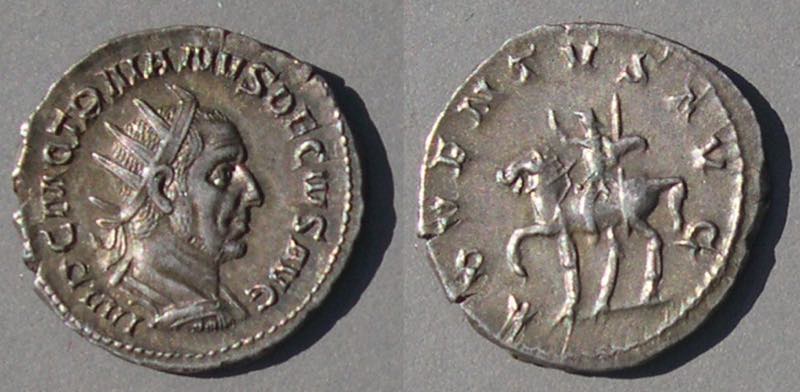
Trajan Decius, 249-251
22 mm.
IMP C M Q TRAIANVS DECIVS AVG
ADVENTVS AVG
RIC 11b. Sear III 9366
Foss Decius 1
Struck 249-250 for his arrival in Rome in 249.

Trebonianus Gallus, 251-253
20 mm.
IMP C C VIB TREB GALLVS PF AVG
ADVENTVS AVG
RIC 79, Antioch. Sear III 9622.
Foss Gallus 1
Struck for his arrival in Rome in 251.

Claudius II, 268-270
21 mm.
IMP CLAVDIVS AVG
ADVENTVS AVG
RIC 13. Sear III 11314.
Foss Claudius II 5
Commemorates his arrival at Rome in 268.

Probus, 276-282
23 mm.
IMP C M AVR PROBVS PF AVG
ADVENTVS PROBI AVG
Emperor riding left, holding up right hand in greeting and holding long scepter in left
seated captive in front below horse's raised leg.
RIC 632H Siscia mint. Sear III 11954v
Foss Probus 1d. Arrival in Siscia in 276.
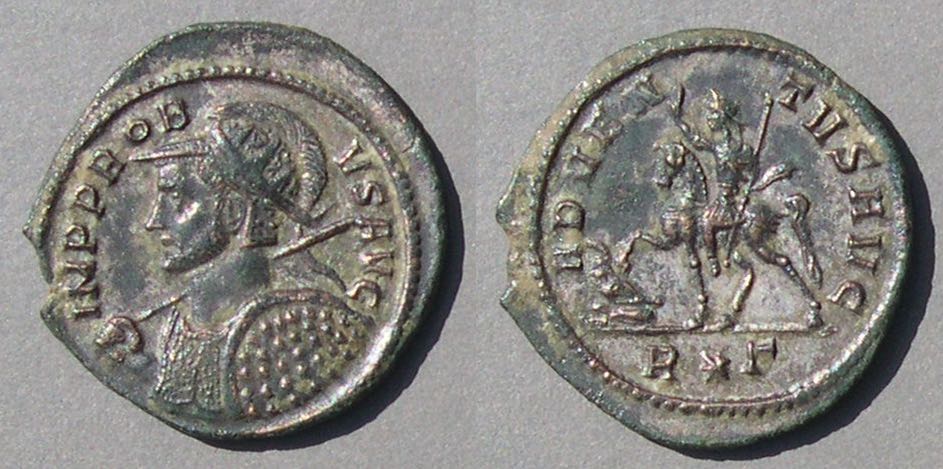
Probus, 276-282
24 mm.
IMP PROBVS AVG
ADVENTVS AVG
Emperor riding left, holding up right hand in greeting and holding long scepter in left
seated captive in front below horse's raised leg.
R*Γ (Rome mint)
RIC V.II 157. Sear III 11953
Foss Probus 7. Arrival in Rome in 277.
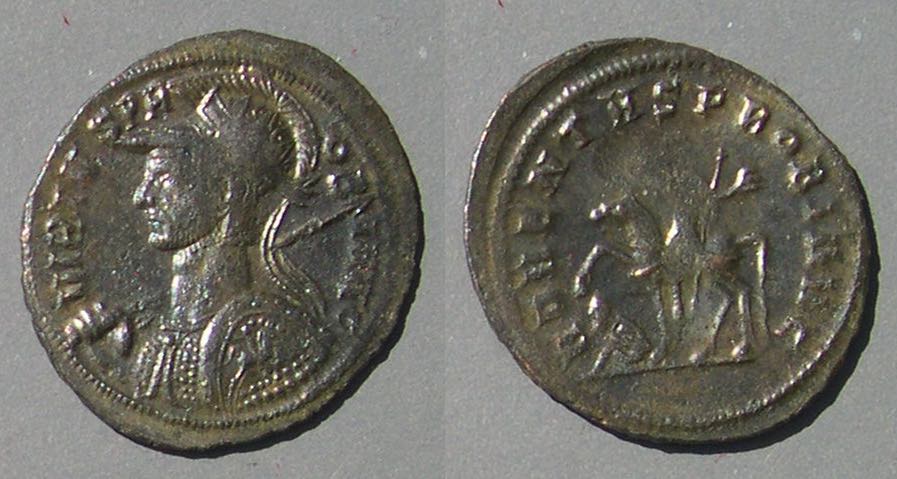 Probus, 276-282
Probus, 276-282
25-22 mm.
VIRTVS PROBVS AVG
Helmented emperor left, spear over far shoulder, on left shoulder
shield with horseman right
ADVENTVS PROBI AVGSear III 11955 var.
RIC -- but RIC 159 is like it but with R<thunderbolt>Z mintmark.
 Maximian, 285-305
Maximian, 285-305
23 mm. 3.98 grams.
Aurelianus, struck c. 290
ADVENTVS AVGG
Two horsemen riding right, raising hands, S in exergue
RIC V.II Maximian 347F, page 261, Lugdunum, AD 290. Very rare.
Bastien 266 p.165, 6th emission, 2nd officina (289-290 AD).
Sear IV 13103.
Foss Maximian 6
Arrival of Diocletian and Maximian to Lugdunum in 290.
This rare type was also issued in the name of his co-ruler, Diocletian.

Maximian, 285-306
28 mm. Struck c. 298 at Carthage
IMP MAXIMIANVS PF AVG
FELIX A-D-VENT AVGG NN
Africa standing front, head left, holding standard and tusk, elephant head headdress, tiny lion on bull at feet left, H (for Herculi) in field, PKB in exergue
RIC VI Carthage 25B. Sear IV 13231.
Foss Maximian 24
Refers to Maximian's arrival in Carthage in 297 after his victories in Africa.
This type was also issued in the names of his co-rulers, Diocletian, Constantius, and Galerius. See the next two coins.
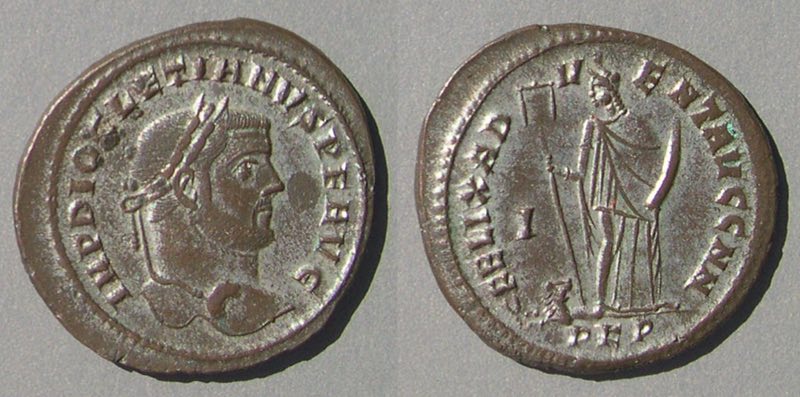
Diocletian, 284-305
29-27 mm.
IMP DIOCLETIANVS PF AVG
FELIX A-D-VENT AVGG NN
Africa standing front, head left, holding standard and tusk, elephant head headdress, tiny lion on bull at feet left, I (for Jovi) in field, PKB in exergue
RIC VI Carthage 23a. Sear IV 12754.
Foss Diocletian 24
Refers to Maximian's arrival in Carthage in 297 after his victories in Africa. This type is really Maximian's, however also minted in the names of his co-rulers.
 Constantius, Caesar 293-305 and Augustus 305-306
Constantius, Caesar 293-305 and Augustus 305-306
28-26 mm. 9.68 grams.
CONSTANTIVS NOB CAES
FELIX ADVENT AVGG NN
PKT in exergue, H in field left (for Herculi)
RIC VI Carthage 24a.
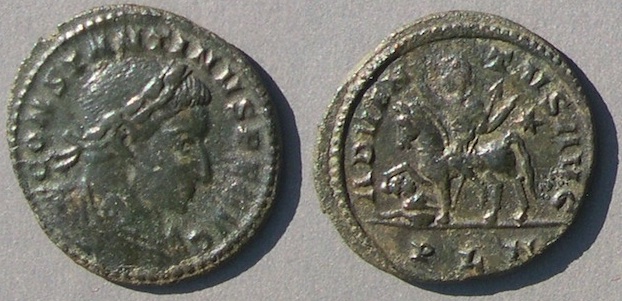
Constantine, 306-307-337
23-22 mm.
CONSTANTINVS PF AVG
ADVEN-TVS AVG
PLN in exergue
RIC VI London 241 "mid 310 - late 312". Sear IV 15860.
Struck for his arrival in London in 310
Emperors with an ADVENTVS type:
Hadrian (His arrival in Rome in 118. Arrivals to numerous provinces were struck near the end of his reign after the travels were completed.)
Commodus (Return to Rome in 176 [gold], to Rome in 180.)
Septimius Severus (To Rome in 196, to Rome in 202, also in anticipation of a trip from Britain to Rome in 211 but he died first.)
Caracalla (To Rome in 202 [One type has a galley. That might indicate Caracalla traveled by sea]. Return to Rome in 211.)
Geta (Return to Rome in 211.)
Elagabalus (Arrival in Rome in 219.)
Philip I (Arrival in Rome in 244.)
Trajan Decius
Trebonianus Gallus (to Antioch)
Volusian (to Antioch)
Gallienus (arrivals to Rome in 260, Milan in 262, Siscia in 267)
Saloninus (RIC dates it to 258)
Postumus (entry to Cologne in 260)
Tetricus I (entry into Cologne in 271)
Claudius II (arrival at Rome in 268)
Aurelian (arrival at Rome in 270. To Milan [gold])
Probus (arrivals at Cyzicus in 276, Serdica in 276, Siscia in 276, Rome in 277, Lugdunum in 277, and Rome in 281)
Diocletian (arrival at Lugdunum in 285 [Foss dates the event to 285 but RIC dates the coin to 290], arrival at Ticinum in 290, and Maximian's arrival to Carthage in 297)
Maximian (arrival of the emperors in Lugdunum in 290, entry into Carthage in 297, to Rome [on gold]))
Carausius (arrival in Britain in 286)
Allectus (arrival in Britain in 293)
Galerius (Maximian's entry into Carthage in 297)
Constantius (Maximian's entry into Carthage in 297)
Constantine (visits to Britain in 307 and 310 and Aquileia in 318 [gold only], Antioch in 324 [gold only], Nicomedia in 325 [gold only]),
Note: Some emperors have ADVENTVS types but have not been included in the above list because their pieces are not in RIC or are extremely rare medallions or gold. They include:
Regular denominations seen in trade (Feb. 2018) but not in RIC, clearly extremely rare: Philip II (arrival in Antioch), Hostilian (to Antioch) [private collection, this image may not have accurate color], Tacitus (a quinarius).
Medallions and unusual gold: Trajan (medallions in silver and AE), Marcus Aurelius, Victorinus (return to Cologne in 269, on gold), Valerian (very rare dupondius-sized two-headed medallion), Carus (To Rome, but he may not actually have gone there. Gold only), Carinus and Numerian (ADVENTVS AVGG NN, arrival to Cyzicus to meet each other, gold only), Tacitus (33 mm bimetalic medallion), Jovian (unique 30 mm medallion) [Stevenson also writes there was an issue for Nero but I have not found it elsewhere--it must be very obscure.]
Comment: I would not be surprised if I have omitted emperors or occasions from this list. If you have any information or suggestions, please contact me. I'm interested! 
Further comments about dating. In the late third century and later it seems gold was issued primarily (only?) when the emperor was present in the mint city. This fact can be used to correlate dates for the itinerary of emperors and their issues of gold coins. For instance, as Constantine moved across the empire we can see gold coins issued from one mint after another [Ramskold]. This relates to the location and timing of corresponding ADVENTVS types.
References, more or less in order of usefulness:
Foss, Clive. Roman Historical Coins. 1990. Hardcover.
Sear, David. Roman Coins and their Values, volumes I-IV
RIC. Roman Imperial Coinage, volumes I-VIII
Stevenson, Seth. A Dictionary of Roman Coins. 1889. Old and not reliable, but often interesting and good for provoking further research into modern sources.
Toynbee, Jocelyn. Roman Medallions. 1986. Page 107 discusses adventus types and says,"During the second century numismatic interest seems to have exhausted itself with the great adventus coin series of Hadrian, recording his many solemn entries into Rome and the provinces. During the whole of the Antonine period from Pius to Commodus, only two coins, both of Commodus, with adventus legend are known to us. This scarcity of adventus coin types lends a special interest to our small series of second-century adventus medallions." (Trajan and Marcus Aurelius)
Estiot, Sylviane. Monnaies de l'Empire romaiin, XII.1 D'Aurelian a Florien. 2004, in two volumes.
Ramskold, Lars. Constantine's Vicennalia and the Death of Crispus. [Available on Academia.edu. This paper is not about adventus types, rather the travels of Constantine and dating.]
https://www.academia.edu/3758586/Constantine_s_Vicennalia_and_the_Death_of_Crispus._2013_Lars_Ramskold._Ni%C5%A1_and_Byzantium_XI_pp._409-456_
Birley, Anthony. Septimius Severus, The African Emperor. 1988. [A biography--not a coin book.]
Go to the companion page on PROFECTIO types that refer to departures.
Go to the main Table of Contents page for this whole site.
 Septimius Severus (193-211) arrives to Rome after receiving his eighth imperatorial acclamation for the defeat of Clodius Albinus in Gaul.
Septimius Severus (193-211) arrives to Rome after receiving his eighth imperatorial acclamation for the defeat of Clodius Albinus in Gaul.






 Probus, 276-282
Probus, 276-282 Maximian, 285-305
Maximian, 285-305



